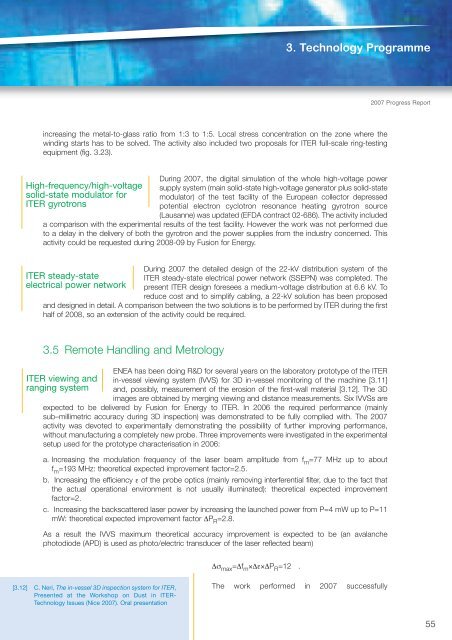Fusion Programme - ENEA - Fusione
Fusion Programme - ENEA - Fusione
Fusion Programme - ENEA - Fusione
- No tags were found...
You also want an ePaper? Increase the reach of your titles
YUMPU automatically turns print PDFs into web optimized ePapers that Google loves.
3. Technology <strong>Programme</strong>2007 Progress Reportincreasing the metal-to-glass ratio from 1:3 to 1:5. Local stress concentration on the zone where thewinding starts has to be solved. The activity also included two proposals for ITER full-scale ring-testingequipment (fig. 3.23).During 2007, the digital simulation of the whole high-voltage powerHigh-frequency/high-voltage supply system (main solid-state high-voltage generator plus solid-statesolid-state modulator for modulator) of the test facility of the European collector depressedITER gyrotronspotential electron cyclotron resonance heating gyrotron source(Lausanne) was updated (EFDA contract 02-686). The activity includeda comparison with the experimental results of the test facility. However the work was not performed dueto a delay in the delivery of both the gyrotron and the power supplies from the industry concerned. Thisactivity could be requested during 2008-09 by <strong>Fusion</strong> for Energy.During 2007 the detailed design of the 22-kV distribution system of theITER steady-stateITER steady-state electrical power network (SSEPN) was completed. Theelectrical power network present ITER design foresees a medium-voltage distribution at 6.6 kV. Toreduce cost and to simplify cabling, a 22-kV solution has been proposedand designed in detail. A comparison between the two solutions is to be performed by ITER during the firsthalf of 2008, so an extension of the activity could be required.3.5 Remote Handling and Metrology<strong>ENEA</strong> has been doing R&D for several years on the laboratory prototype of the ITERITER viewing and in-vessel viewing system (IVVS) for 3D in-vessel monitoring of the machine [3.11]ranging system and, possibly, measurement of the erosion of the first-wall material [3.12]. The 3Dimages are obtained by merging viewing and distance measurements. Six IVVSs areexpected to be delivered by <strong>Fusion</strong> for Energy to ITER. In 2006 the required performance (mainlysub–millimetric accuracy during 3D inspection) was demonstrated to be fully complied with. The 2007activity was devoted to experimentally demonstrating the possibility of further improving performance,without manufacturing a completely new probe. Three improvements were investigated in the experimentalsetup used for the prototype characterisation in 2006:a. Increasing the modulation frequency of the laser beam amplitude from f m =77 MHz up to aboutf m =193 MHz: theoretical expected improvement factor=2.5.b. Increasing the efficiency ε of the probe optics (mainly removing interferential filter, due to the fact thatthe actual operational environment is not usually illuminated): theoretical expected improvementfactor=2.c. Increasing the backscattered laser power by increasing the launched power from P=4 mW up to P=11mW: theoretical expected improvement factor ΔP R =2.8.As a result the IVVS maximum theoretical accuracy improvement is expected to be (an avalanchephotodiode (APD) is used as photo/electric transducer of the laser reflected beam)Δσ max =Δf m ×Δε×ΔP R =12 .[3.12] C. Neri, The in-vessel 3D inspection system for ITER,Presented at the Workshop on Dust in ITER-Technology Issues (Nice 2007). Oral presentationThe work performed in 2007 successfully55













